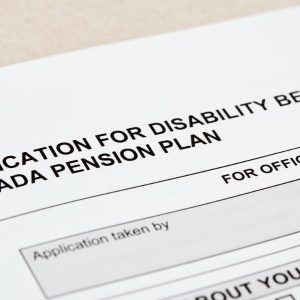What's Important
For anyone shopping for individual disability insurance in Canada, it’s important to understand these 6 notions. One should not purchase disability insurance without understanding these concepts.
1 - Elimination and Benefit Periods
Elimination Period
Also known as a waiting period, it determines how long an insured must wait after becoming disabled before they become eligible to receive income benefits.
A short, or no elimination period protects against short-term disabilities, but prices increase with shorter elimination periods. It’s wise to plan a policies elimination period around existing benefits such as Employment Insurance (EI), WSIB, or other private disability benefits to maximize benefit integration and reduce costs. Simply having no elimination period is seldom the most efficient way to plan.
Benefit Period
This determines how long income benefits last after an insured becomes disabled. Benefit periods can range anywhere from 1 year up to age 70. The longer the benefit period the more expensive the coverage.
It is common for definitions of disability to change from “regular occupation” to “any occupation” after 2 years of disability, for a policy is not modified with riders. See sections 3 and 5 to better understand definitions of disability and riders.
2 - Types of Disability Insurance
Disability insurance can be broken down into 4 categories. These categories are made up of policies that share a similar profile in how they define disability, how they integrate with other benefits, qualification standards, and available riders.
Non-cancellable disability insurance means that the insurance company can’t cancel the policy, though the policy owner can. This eliminates the risk associated with changing jobs, industries, or having a reduction of income. Qualification is the most stringent and least likely to cover pre-existing medical conditions. Integration of benefits is most likely and definitions the most likely to be favorable. This is the ideal policy for anyone who can qualify.
Guaranteed Renewable means that the policy renews itself every year until it’s term is complete. This renewal allows the insurer to make changes to the policy as long as they are done for an entire cohort and not an individual policy. Because these plans typically verify income at the time of claim, job and income impact coverage. Many other characteristics resemble Non-Cancellable policies though Guaranteed Renewable may be more price competitive for more manual occupations (manual occupations are considered higher risk).
Simplified Issue carries many of the same characteristics as Guaranteed Renewable in that it is renewed annually, though qualification is less strict. Where Non-Cancellable and Guaranteed Renewable may entail a nurses visit or the requisition of your medical file (at time of application), Simplified Issue does not.
The risk of a declined application is minimal with Simplified Issue because the medical questions on the applications are usually knock-out questions. How you answer the application questions directly determines if you qualify or not. You can determine whether you qualify simply by reviewing the application.
With Simplified Issue, it’s important to understand your policies income requirements. A disability benefit is meant to cover an earned income, that income must exist for a claim to be paid. Proof of income is usually not verified by the insurance company at application time. This means the insured must prove they meet the minimum income required for their policy to receive their benefit if they claim.
Also, pre-existing conditions are not dealt with on a case-by-case basis with Simplified Issue so it’s important to understand your policies approach to pre-existing medical conditions and how you’re implicated. Some may be covered while others are not.
Accident only disability insurance, like all other disability insurance pays a monthly benefit in the event of disability but it does not cover illnesses. These policies are most suitable for those who have been declined for other disability policies, or those looking for simple issuance at affordable rates. This insurance pairs well with critical illness insurance to target disabilities due to catastrophic health conditions. Paring accident only disability insurance with critical illness insurance may lower cost of covering life altering health conditions.
Eligibility requirements are minimal meaning there are few health, income, and occupation related questions asked on applications. Some policies may also be issued without a medical questionnaire.
3 - Definitions of Disability
Disability means something different to everyone. It’s important to understand how an insurance policy defines disability. Here are some definitions;
While the specific parameters of what it means to be totally disabled will vary from one policy to the next, it generally means that you are unable to reasonably perform the functions of an occupation whether it be your job (own occupation), a similar job (regular occupation), or any job (any occupation).
Total disability is typically required to be entitled to benefits unless partial disability or residual disability riders have been added to a policy.
Like total disability, the parameters of partial disability may vary from one policy to the next, but it generally means that an insured is working but can’t perform one or more important duties of their job or are unable to work more than 50% or their normal working hours. Partial disability is typically an optional rider (add-on) and pays a percentage of the monthly benefit for a pre-defined disability period.
Like total and partial disability, the parameters of residual disability may vary from one policy to the next. Residual disability, like partial disability is an optional rider (add-on) that can be added to a policy to improve the definition of disability, making it more inclusive than partial disability.
Residual disability typically takes the advantages of partial disability further by offering all the same benefits while also defining disability on income basis. If an insured suffers a loss of income in excess of 20%, they may be entitled for benefits and for a much longer period of time that would be available with partial disability.
While most disability insurance policies, require an insured be considered totally disabled to be eligible for income benefits, what constitutes total disability may vary. Below are common definitions of total disability.
The “Regular occupation” definition of disability states that if an injury or sickness directly interferes with an insured’s ability to perform an important part of any occupation for which you are reasonably suited, then they’re eligible to receive disability benefits. You don’t qualify for benefits if you can work in a different job from the one you had before your disability, based on your training, experience and education
The “Regular occupation” definition of disability states that if an injury or sickness directly interferes with an insured’s ability to perform an important part of their regular occupation, then they’re eligible to receive disability benefits. How their occupation is defined would not be contextualized to their specific job or organization but would be standardized as to what is regularly required. This definition of disability is most suitable to non-management employees.
The “Own occupation” definition of disability states that if an injury or sickness directly interferes with an insured’s ability to perform an important part of their own occupation, they’re eligible to receive disability benefits. This definition is known as being the most lenient because the injury or sickness only has to prevent the insured person from working their specific job however it is defined within the context of their job. This definition of disability is most suitable to those who are self employed in white-collar occupations.
4 - Integration of Benefits
Integration of benefits determines how one disability income benefit interacts with another. Some disability insurance policies pay on top of other income benefits regardless of amount while others top up other income benefits to a determined level.
Integrated income benefits are an income benefit that tops up other benefits to a determined amount while non-integrated benefits pay on top of other income benefits. Non-Integrated benefits are ideal whenever available, but insurance companies often only offer this type of benefit for certain occupations. Low benefit amounts may also be found as non-integrated benefits.
Example
Peter purchased disability insurance with a $4,000 monthly benefit and is now disabled. He’s receiving $1,000 monthly from employment insurance (EI).
With integrated benefits, he would receive another $3,000 from the insurance company bringing his monthly income to $4,000.
With non-integrated benefits, would receive $4,000 from the insurance company bringing his monthly income to $5,000.
Because WSIB may cover a large portion of someone’s income if injured at work, non-occupational benefits are available. This benefit would be paid only if disability were the result of an accident or illness non-work related to allowing for WSIB to cover all work-related disability without overlap. Non-occupational benefits may provide significant cost savings.
5 - Qualification
If you’re looking for the best possible disability insurance on the most favorable terms, it is important to first determine whether you would qualify for coverage. Some insurance companies may approve you while others may not. Find what kind of coverage would be best suited to you.
6 - Riders
Riders are optional contract modifications that are used for the purpose of improving benefits. While these riders do cost extra, they can be crucial in tailoring a policy to fit a specific occupation or person. Below are common riders available for disability insurance. It’s important to discuss riders with your broker to understand whether they may be suitable or necessary in your case.
The “Own Occupation” definition of disability is not standard on most policies. As the most coveted definition of disability, it can only be added as a rider to “Non-Cancellable” policies. This rider is important for white-collar business owners because the tasks of their occupations are similar to that of running a business. Without the “Own Occupation” definition of disability, the self-employed accountant or web developer may not be able to participate in the maintenance of their business if disabled and collecting benefits.
This rider improves the policy by extending how long the “Regular Occupation” definition of disability is applied to a disability. Usually the definition of disability changes after an insured is disabled for 2 years. After 2 years, the “Any Occupation” is applied to disabilities which is more restrictive potentially leaving the insured unprotected. Having this rider can protect the insured from long-term disabilities by extending the “Regular Occupation” definition of disability to 5 years or even the life of the policy.
Partial disability is optional upgrade on a disability insurance policies standard definition of disability. Typically, one must be unable to perform important duties of their job and be fully absent from work to be illegible to receive disability benefits. By adding this rider to a policy, an insured may be eligible to receive partial benefits if they are unable to work more than 50% of their working hours.
This optional definition of disability is an upgrade on the partial disability rider. Unlike partial disability that is based on workable hours, residual disability defines someone as partially disabled, and eligible for partial benefits if they suffer a loss of income in excess of 20% due to an accident or illness. This rider widens eligibility for income benefits beyond what the partial disability rider can.
Future Insurability Option is an optional rider that allows the insureds to purchase additional disability coverage at pre-defined rates, on select policy anniversary dates without having to show proof of medical insurability. Medical proof of insurability means approval of an application based on a medical questionnaire.
This is most suitable for those who are anticipating increases of income but cannot commit to purchasing additional coverage now due to budget constraints. If the insureds health status were to decline while coverage is in effect, they would still have the option to purchase additional coverage whereas they may be declined if proof of medical insurability were required.
Also known as COLA, the cost-of-living adjustment rider is used in long term disability insurance to index the monthly benefit to inflation. During the insureds disability, their monthly benefits will be adjusted annually based on the percentage change of the consumer price index (CPI). Some insurance companies may set minimum and maximum annual benefit increases on this rider.
If the insured recovers from their disability prior to the expiry of their policy, they may be eligible to purchase more coverage up to the increase in benefits without having to prove medical insurability. This rider is not recommended for policies with benefits periods of less than 5 years.
Return of premiums is one of the most attractive riders because it eliminates the idea that you’ve wasted money by not becoming disabled. This rider will either return a portion or all premiums paid into the policy at specific policy anniversaries (or at expiry) if the insured does not claim on the policy, or if the insured dies. This can be used as a forced savings or to plan retirement as policy owners can end with large lump sum tax free payout after their working years are complete. Disability insurance with return of premium is one of the safest investments you can make.
Disability insurance policies may have a variety of riders surrounding the concept of accidental death, dismemberment, or fracture. These riders typically pay out a lump sum tax-free payout if an insured dies due to accident, looses a limb, goes blind/deaf or fractures a bone. Riders may cover accidental death but not dismemberment, or fracture only. Typically fracture benefits will differ based on which bone is fractured. A femur for example would pay out more than a finger. If interested, ask your broker about accident related benefits.
Overnight hospitalization in a ward covered by all provincial public health insurance in Canada. Hospital benefits on disability insurance cover what provincial public health plans don’t, such as semi-private accommodation. You may also get hospital allowance which is a monetary benefit for everyday spent in hospital. The benefit is designed to make catastrophic incidents slightly less stressful and set the stage for healing.
Our Insurance Providers







Disclosure
All quotes are provided by Red Helm Insurance Ltd. FSRA license #37440M, an independent brokerage specializing in health benefits. While all effort is made to ensure accuracy, quotes, rates, and plan details may be subject to review or change without prior notice. Plan eligibility is not guaranteed and may be subject to a medical questionnaire or other eligibility criteria. By submitting your information in our quote request form, you are accepting the terms and conditions of our website and are accepting that we communicate with you electronically for the purpose of solicitation.





